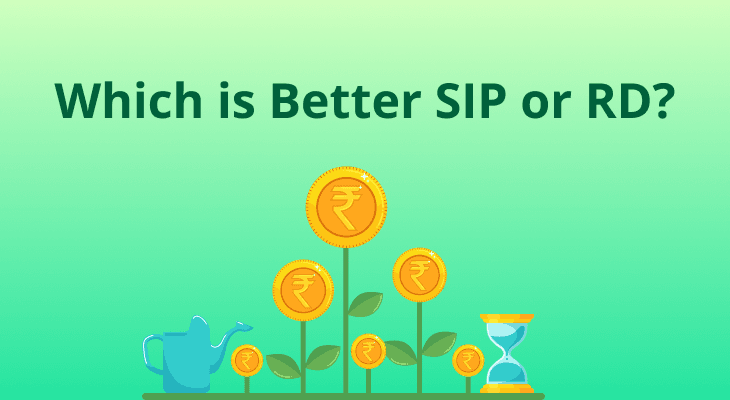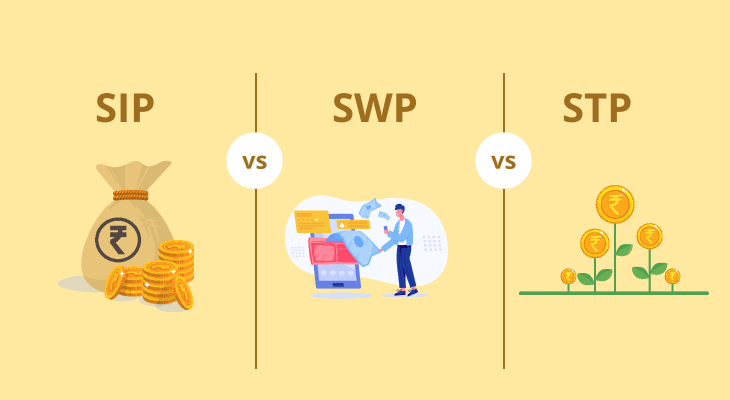
Which is Better SIP Or RD?
In India, there are many investment options that allow you to create wealth over the long term with minimal monthly contributions. Out of the plethora of choices available, SIPs and RDs are consistently among the most popular.
Both SIP and RD are fundamentally different investments and are designed for investors with contrasting risk tolerance levels. Wondering which among these two is the better investment option? Here’s a comprehensive guide outlining the differences between a SIP and an RD.
What is a SIP?
A Systematic Investment Plan (SIP) is a method that allows you to invest a fixed sum of money regularly in an asset at your desired frequency for a predetermined tenure. Most investors opt to invest in a mutual fund via SIP. However, you can also use the method to invest in individual stocks as well. Here’s a hypothetical example to help you better understand how a mutual fund SIP works.
Let’s say that you’re interested in investing in an equity mutual fund. Since you don’t have a lump sum capital, you opt for a SIP where you invest Rs. 2,000 each month in the fund for a tenure of 5 years. According to the terms of the plan, Rs. 2,000 will be debited from your bank account each month and used to purchase units of the mutual fund at the Net Asset Value (NAV) as of the date of purchase.
This cycle of purchasing mutual fund units with a Rs. 2,000 investment continues each month until the end of the tenure. Once the SIP tenure ends, you can choose to remain invested, start a new SIP in the same fund or redeem all of the units you’ve accumulated up until that point.
What are the Benefits of SIP?
Now, before we take a look at the comparison between SIP vs. RD, let’s quickly look at the various benefits of a Systematic Investment Plan.
By encouraging you to make regular investments, a systematic investment plan inculcates financial discipline.
You don’t require large capital to start a SIP. Some Asset Management Companies (AMCs) allow you to invest as low as just Rs. 500 per month.
Regular investments in a mutual fund SIP can help you lower your overall cost of investment through a phenomenon known as rupee cost averaging.
When you reinvest your mutual fund returns in the SIP, you get to enjoy a compounding effect, which can boost your returns.
With SIPs, you get the freedom and flexibility to select the investment amount, frequency and tenure. You can even increase, decrease or temporarily stop investments as well.
What is an RD?
A Recurring Deposit or RD is an investment option offered primarily by financial institutions like banks. In an RD, you’re required to invest a fixed sum of money each month for a certain tenure. In exchange for making these regular deposits, the bank pays interest on your investment at a certain rate. Here’s a quick example to help you understand how a recurring deposit works.
Assume you start an RD with a bank. You choose to invest Rs. 5,000 each month for a tenure of 24 months. The bank, in exchange for these deposits, is willing to offer interest on your investment at the rate of 7.5% per annum. Now, assuming you don’t miss any deposits for the entire tenure, the amount you would get on maturity would be Rs. 1,29,776.
What are the Benefits of RD?
Before we look at the detailed comparison between SIP vs. RD, let’s quickly look at the list of benefits you get to enjoy by investing in a Recurring Deposit.
Unlike other investment options, the returns from a Recurring Deposit are fixed and guaranteed.
Recurring Deposits offered by banks are considered to be low-risk investments and may even qualify for deposit insurance by the Deposit Insurance and Credit Guarantee Corporation (DICGC).
Many banks and financial institutions allow you to avail a loan against your Recurring Deposit to meet emergency financial requirements.
The interest you receive from a Recurring Deposit can be claimed as a deduction from your total income under section 80TTA of the Income Tax Act, 1961. The maximum amount that can be claimed is limited to Rs. 10,000 per financial year.
Difference Between SIP and RD
Now that you’ve seen what a Systematic Investment Plan and a Recurring Deposit are, let’s compare both of these options to determine how they differ from each other.
Particulars | Systematic Investment Plan | Recurring Deposit |
|---|---|---|
Investment Frequency | You can choose to invest in a SIP on a monthly, quarterly, semi-annual or annual basis. | You can only invest in an RD on a monthly basis. |
Maximum Tenure | With SIPs, there’s no maximum tenure. | With Recurring Deposits, the maximum tenure you can opt for is generally limited to 5 years. |
Investment Options | You have the option to start a SIP in any type of mutual fund, be it equity funds, debt funds or hybrid funds. | You don’t get any investment options with Recurring Deposits. |
Returns | The returns from a SIP are market-linked and not guaranteed. | The returns from an RD are fixed and guaranteed. Depending on the financial institution you opt for, you can get a return ranging anywhere from 7% to 9% per annum. |
Risk | Systematic Investment Plans invest in high-risk market-linked assets like equity shares or mutual funds. | Compared to SIPs, Recurring Deposits are low-risk instruments. In the case of bank RDs, you even get deposit insurance coverage of up to Rs. 5 lakhs from DICGC. |
Tax Benefits | Long-term capital gains from a SIP are only taxed if they’re above Rs. 1 lakh in a financial year. | The interest from an RD can be claimed as a deduction under section 80TTA of the Income Tax Act, 1961 to the tune of Rs. 10,000 per financial year. |
Liquidity | Both mutual funds and stock SIPs are highly liquid and can be sold or redeemed even before the end of their tenure. | Recurring Deposits are also liquid, however, prematurely withdrawing them before the end of their tenure may incur penalties. |
SIP or RD: Which is Better?
With this, you must now be aware of the differences between SIP and RD. But then, which of the two investments is right for you? Here’s something that can help give you some clarity.
A Systematic Investment Plan is designed for investing in market-linked financial instruments like mutual funds or stocks. This makes them suitable for individuals with a penchant for high-risk investments. Moreover, the returns from a SIP are also not guaranteed. Therefore, if you have a high tolerance for risk and want to invest in the stock market, you may consider starting a Systematic Investment Plan.
A Recurring Deposit, on the other hand, is a low-risk investment that offers predictable and guaranteed returns on your investment. Unlike a SIP, its performance is not dependent on the movement of the financial markets. However, the returns from an RD are generally lower compared to market-linked investments and SIPs. If you’re a conservative investor with low-risk tolerance and wish to invest in an option that provides fixed returns, you may consider a Recurring Deposit.
Conclusion
As you can see from the comparison between an SIP vs. a Recurring Deposit, both of these investment options have their own set of advantages and limitations. The choice between either of these two should be taken only after considering a multitude of factors like your financial goals and risk profile, among others. Also, remember to use a SIP return calculator and an RD calculator to estimate the amount of returns you’re likely to generate before investing. This can help you make a more informed investment decision.


